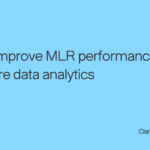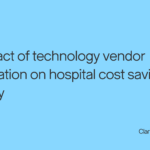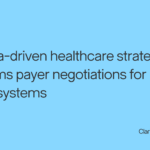Maximizing operational efficiency is a goal in many industries, but it’s particularly critical in healthcare. Diverse populations of patients with complex and unique needs, growing regulatory and administrative requirements, and escalating costs all contribute to the challenge for health plan networks that want to provide quality care while balancing financial, economic, and logistical factors. In a 2021 report, the U.S. ranked last among 11 high-income countries for healthcare efficiency, outcomes, access to care, and equity. Fortunately, healthcare data can provide health plans with the insights and information to appropriately benchmark network efficiency and performance over time. Here’s an overview of how health plan leaders can leverage data analytics in healthcare to identify optimal and high-performing care settings, help providers care for high-risk populations, and tailor network coverage—all of which promote improved cost efficiency, better patient outcomes, and increased profitability. Data analytics platforms can incorporate historical healthcare data to develop predictive models that forecast the likelihood of future patient care needs and identify care settings and procedures that can help prevent complications or other adverse outcomes. For example, comparing and analyzing data on patients who undergo the same surgical procedure can uncover where in their journey there is a greater chance that they may need to visit an emergency facility or be readmitted to a hospital due to complications. Providers can then proactively manage care to prevent such outcomes by scheduling regular post-operative check-ins or educating patients on the warning signs of infection. As a result, health plans can reduce the frequency of hospital readmissions and emergency room visits. This reduces costs for both the network and patients, enhances outcomes, and supports more efficient network usage. Certain patient populations are at higher risk of developing different diseases. They may have a family history of cancer or diabetes, or their medical history and test results may indicate a propensity toward obesity or high cholesterol. Others may be more vulnerable to specific conditions due to their age, ethnicity, or socioeconomic background. Health plans can use clinical healthcare data to identify and segment these at-risk patients, and then develop care pathways and interventions to prevent or manage those conditions in the most appropriate and cost-effective settings. Patients with high cholesterol could be prescribed statins or sessions with a dietitian to improve their eating habits, while those with an elevated cancer risk might be scheduled for more frequent scans and tests to detect abnormal cells. By taking these actions, health plans can manage resources, reduce the need for more expensive treatments, and even save patients’ lives. They also make their networks more attractive to new members by offering access to high-quality providers focused on preventative care. Data on how patients use existing services in a network can reveal where there is demand. An area with an aging population may need fewer providers specializing in maternity care, for example, but may see a greater demand for facilities offering physical rehabilitation, memory care, and other care associated with senior patients. Comparing costs and patient outcomes can also show if sites offer efficient care delivery. Inefficient triage or discharge procedures can waste time and other critical resources, delaying or preventing care for patients with serious issues and driving up costs when more expensive procedures are needed. A lack of communication and coordination among healthcare teams can result in redundant tests or treatments. Analyzing this data can help health plans decide where more or fewer facilities or providers are needed in a network. They can also use it to remove lower-performing providers that regularly incur higher costs from networks. Furthermore, the savings from site of care optimization help health plans offer more competitive and affordable premiums, cultivating greater satisfaction and retention among their members. In addition to monitoring efficiency, health plans can use healthcare data analytics to establish metrics for benchmarking performance. By continuously measuring care quality, outcomes, and patient satisfaction scores across all of the sites in a network, they can identify specific sites of care, types of care, or processes that are falling short. Health plans can then take action to implement best practices from high-performing, high-quality facilities atto those that need improvement. This can also support a more consistent patient experience across the network and greater compliance with care protocols. Beyond supporting better care at individual providers, health plans with metrics that show high-quality care across the network are more likely to attract new members and s well as fruitful partnerships with other high-quality providers. This also shows the plan’s attention to value-based care, which can be a strong competitive advantage as the model increasingly gains traction in the industry. The need for different healthcare services in a network can change due to shifts in member demographics and population density. Health plans can optimize network coverage by combining geospatial analysis and current site locations to see where there are gaps in accessibility to primary, specialty, and emergency sites of care. Using this information and monitoring changes can help health plans ensure that the number, type, and location of sites of care continuously align with member needs, supporting greater satisfaction and retention. They can make plans to expand into underserved areas, potentially attracting more members and increasing their market share. Using data analytics in healthcare allow health plans to uncover insights and trends across multiple aspects of care delivery and quality that support more accurate decision-making about network efficiency. Seeing where sites are needed or underused, identifying which care pathways support the best patient outcomes, and staying up to date with shifts in member demographics can help ensure that networks continuously provide access to the high-quality and accessible care that members need. A focus on network efficiency helps health plans realize greater profits and ensure they continue to offer cost-effective care to members, increasing their satisfaction with the value of their plan. These are key to ensuring a health plan’s success over the long term—especially as the industry grows more competitive and patients continually reevaluate their options for value, quality, and affordability. Using healthcare data to model patient journeys for optimal care
Identifying high-risk patients to improve population health
Exploring service utilization and costs
Identifying areas for improvement
Optimizing network coverage
Efficiency drives network growth and success
- Author Details





